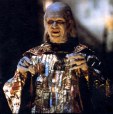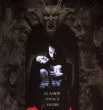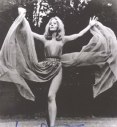
Click on thumbnails to view full-size images.
The 1992 version of Bram Stoker's Dracula, starring Gary Oldman (Dracula), Keanu Reeves (Jonathan Hawker) and Winona Ryder (Mina Hawker), marked the first time that all the major characters from Stoker's novel were all present a film. This film also faithfully followed Stoker's novel, save for some slight changes; the portrayal of Mina as the reincarnation of Vlad's dead wife, for example, as well as the humanization of Dracula, allowing him human emotions, like grief, love, etc. and effectively portraying him as more of a man then a monster.
Dracula 2000, recently joining the ranks of Dracula movies, was supposed to be a hipper, trendier version, with a new twist to the old tales. However, director Wes Craven's off-putting habit of sensationalizing his movies with sex, gratuitous violence, an overabundance of gore, and unoriginal storytelling make this movie a chore to watch. It is very unfaithful to Stoker's novel, and perhaps the only thing it had in common with Stoker's Dracula is its first name.
Nosferatu, eine Symphonie des Grauens, or Nosferatu, a symphony of horror, (1922) was never supposed to be filmed. When German director F.W. Murnau approached Florence Stoker, Bram's widow, with the idea of putting Dracula on the big screen, she adamantly refused. However, not to be put-off, Murnau simply changed location names, as well as the names of the characters, and filmed it anyway. Max Schrek was cast as the pale, rodent-like Count Orlok, and filming commenced; despite the changes, the story was still Stoker's, and Schreck brilliantly portrayed the evil Count. However, in 1925, Florence Stoker won her lawsuit against Murnau, and prints and negatives of the film were ordered destroyed. Luckily, copies of the film were pirated, and kept from being destroyed and today it is hailed as one of the greatest vampire movies ever made.
Shadow of the Vampire, starring John Malkovich as F.W. Murnau, and William Defoe as actor, Max Schreck, is a fanciful tale about what happened behind the scenes of Nosferatu. It brilliantly captures the almost mad genius of Murnau, who, in order to film his masterpiece, went to great lengths to do so. Not only stealing another man's idea, but also casting 'real life' vampire, Count Orlok, promising him he was allowed to eat his co-actress after filming. Defoe expertly captures the rat-like, grotesque Orlok, and Malkovich's intensity as the nearly insane Murnau captures the audience.
Blacula, starring Shakespearean actor, William Marshall, is a 1972 variation of the same old Dracula tale. However, this movie was an attempt to draw in an African American audience into the genre of vampire films. Despite it's many shortcomings, one being plot, this fast became a cult classic among 1970s black cinema goers. African Prince Mamuwalde (Blacula), however, was portrayed as a sensitive vampire, who felt remorse after killing his victims. More human then demon, guilt finally drove him to commit suicide in the end. In 1973, Scream, Blacula, Scream, its sequel, came out in theaters, but it failed, never achieving the cult status that Blacula did.
Hammer Films, a production company, made notorious for their somewhat graphic and violent films, released Countess Dracula in 1971. The title of the movie was misleading, however, since it actually told the story of Elizabeth Bathory, who was born over a hundred years after Vlad Dracula. Elizabeth Bathory was a real life woman, who believed that she could obtain eternal youth and beauty by bathing in the blood of young girls and women. Countess Dracula dealt more with her psychological fixation with blood, and the downward mental spiral she was experience. Though the story isn't the same, and it isn't about Dracula, it does deal with the idea that blood equals immortality and unending beauty. However, low budget and a stunted script dragged down what might have been a successful film.
The Lost Boys came out in 1987, and immediately became a huge hit with teenage audiences everywhere. A pack of teenaged vampires wreak havoc on a small town, led by Kiefer Sutherland. The story deals with the seduction of innocence and jealousy. When a teenage boy, Patric is bitten and finds himself turning into a vampire, and challenges the authority of the pack leader. After Patric's little brother, saves him, the pack comes after them, looking for revenge, and the group of boys are forced to defeat the vampires, to save the town and themselves. This movie has come under fire, sometimes due to it's Anachrist leanings and by metaphysicsists for its overuse of vampire lore. Though a cult favorite, its content is a bit trite due to afore mentioned abuse of vampiric tradition.
'Salem's Lot, a TV movie that aired in 1979, was based on Stephen King's novel of the same name. King's novel, which was published in 1975, and became an almost instant hit, and kick-starting the now prolific writer's career into drive. King admittedly based his vampire, Barlow, on Bram Stoker's Dracula, and in fact, the smooth, charming vampire had very Dracula-like mannerisms. However, in the TV movie, Barlow said nothing the entire time, and his appearance very much took on alone the lines of Count Orlok in Nosferatu. (See Nosfertu)
Count Duckula was a cartoon that aired between 1988-1993, and was popular among children. Duckula was an animated vampire-duck, who also happened to be a vegetarian, with an evil butler who tried to feed him meat and an avid vampire hunter called Duck Van Helsing. Dracula, either myth or fact, manages to reach the children somehow. Be it through children's books, like Bunnicula, a tale of a veggie-draining rabbit, through cartoons, or even characters on a cereal box (i.e. Count Chocula), or even the Counting Count on Sesame street, children are learning about vampirism (mildly) and the legend of Dracula at an early age, minus most of the violence and carnage, that is.
Popular TV series, Buffy the Vampire Slayer, jumps on the Dracula bandwagon in 2001. In it's fifth season, main character, ditzy Californian Buffy Summers, the one girl chosen in all of the world to slay vampires, faces off against the Dark Prince.
Questions/Comments? Fill out form and I'll get back to you as soon as possible














